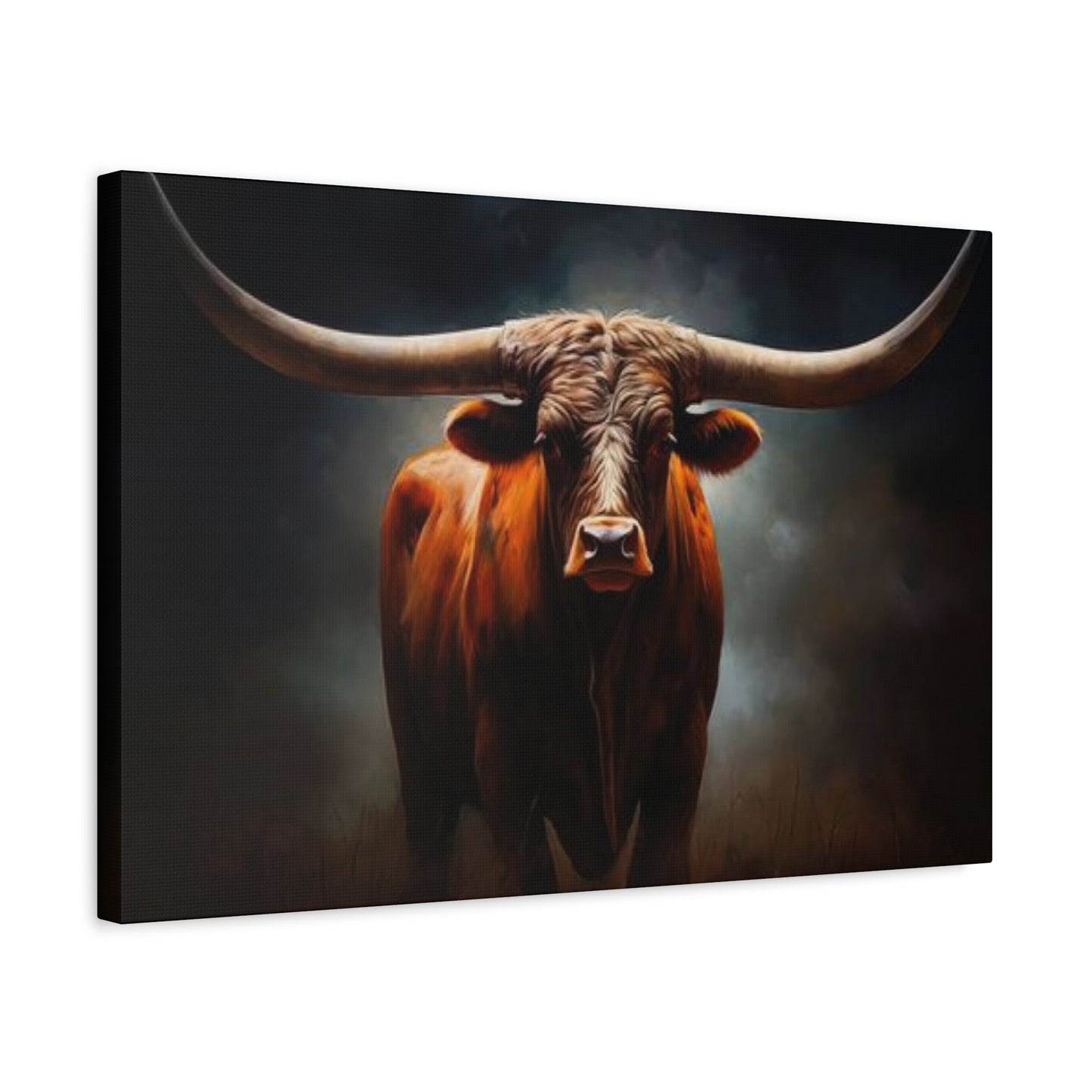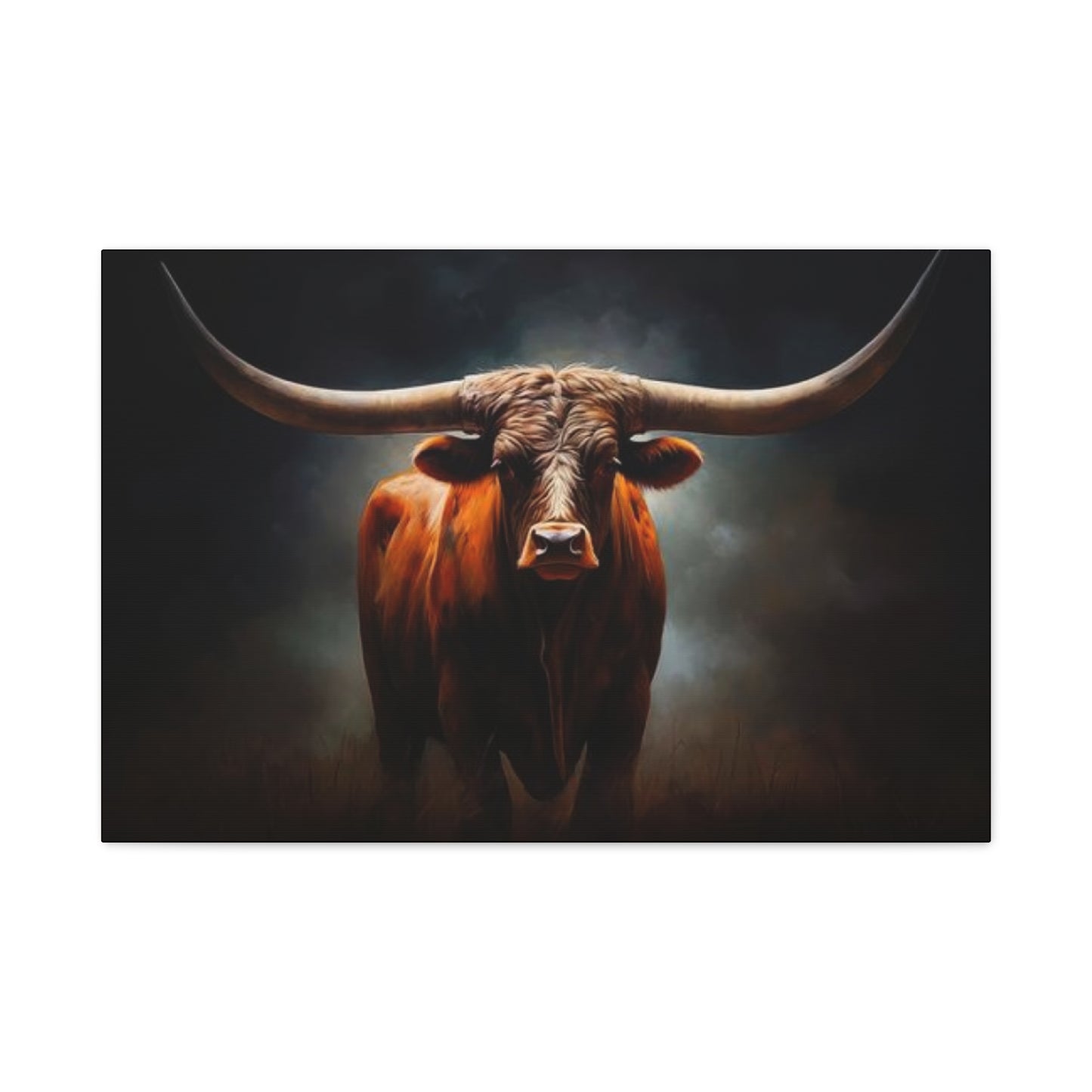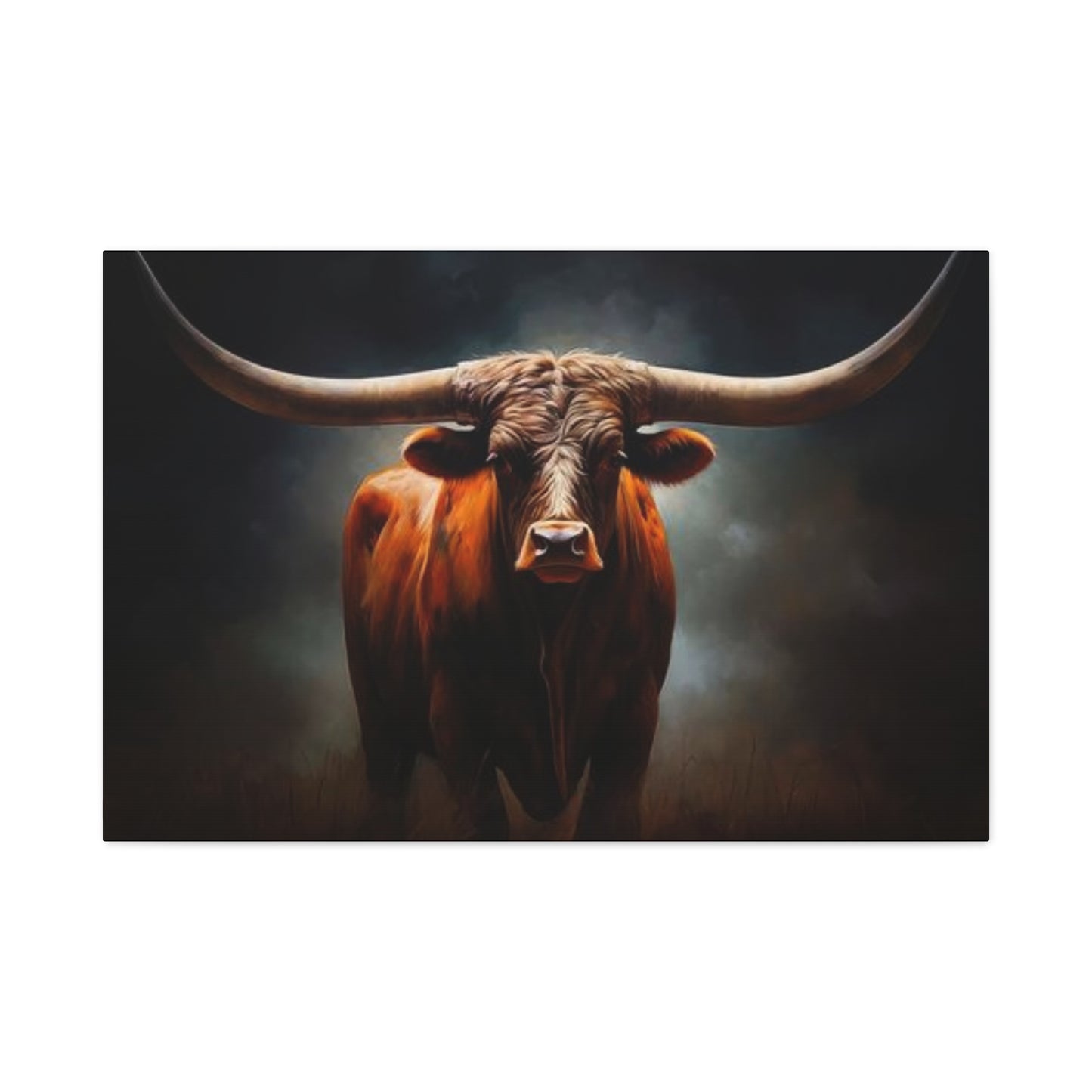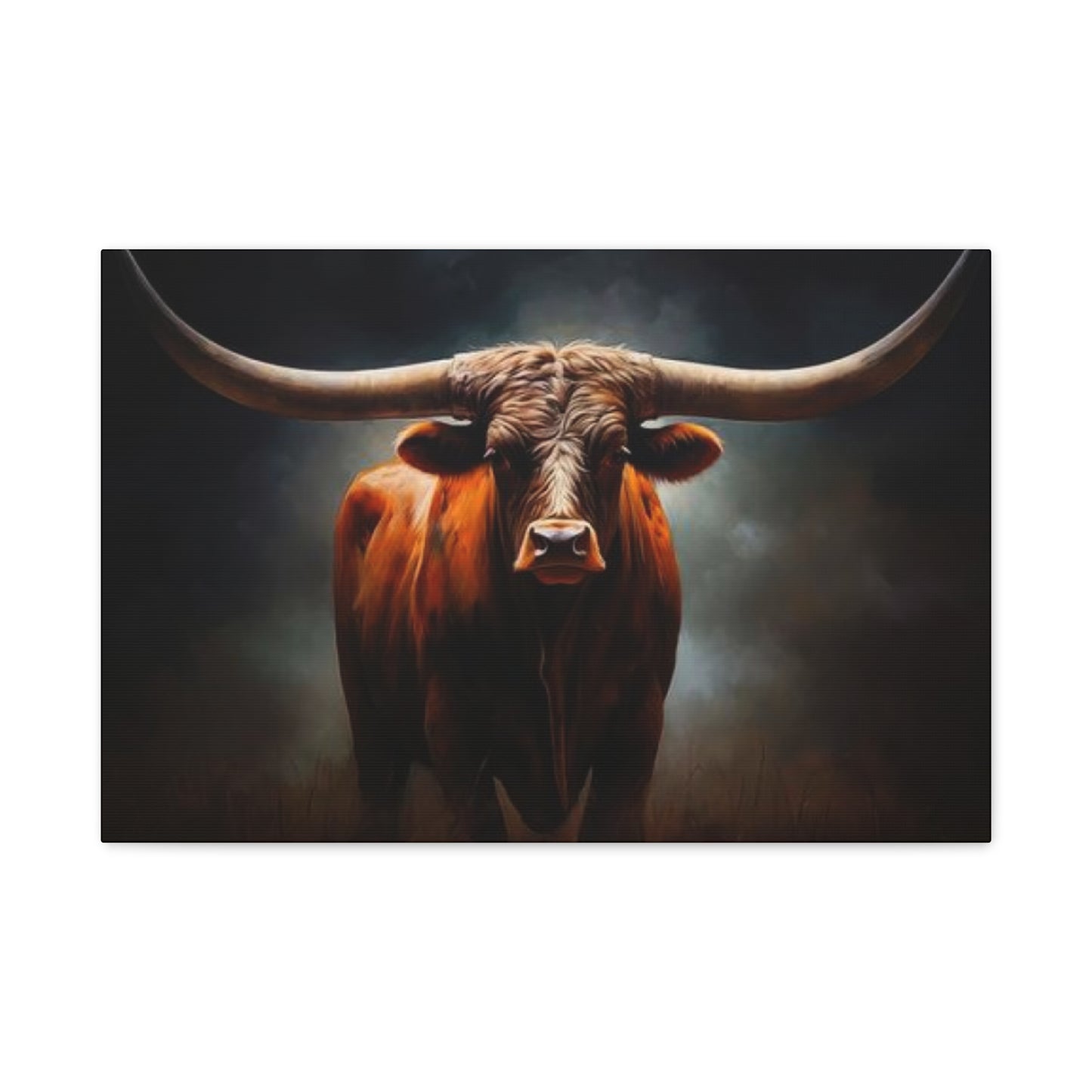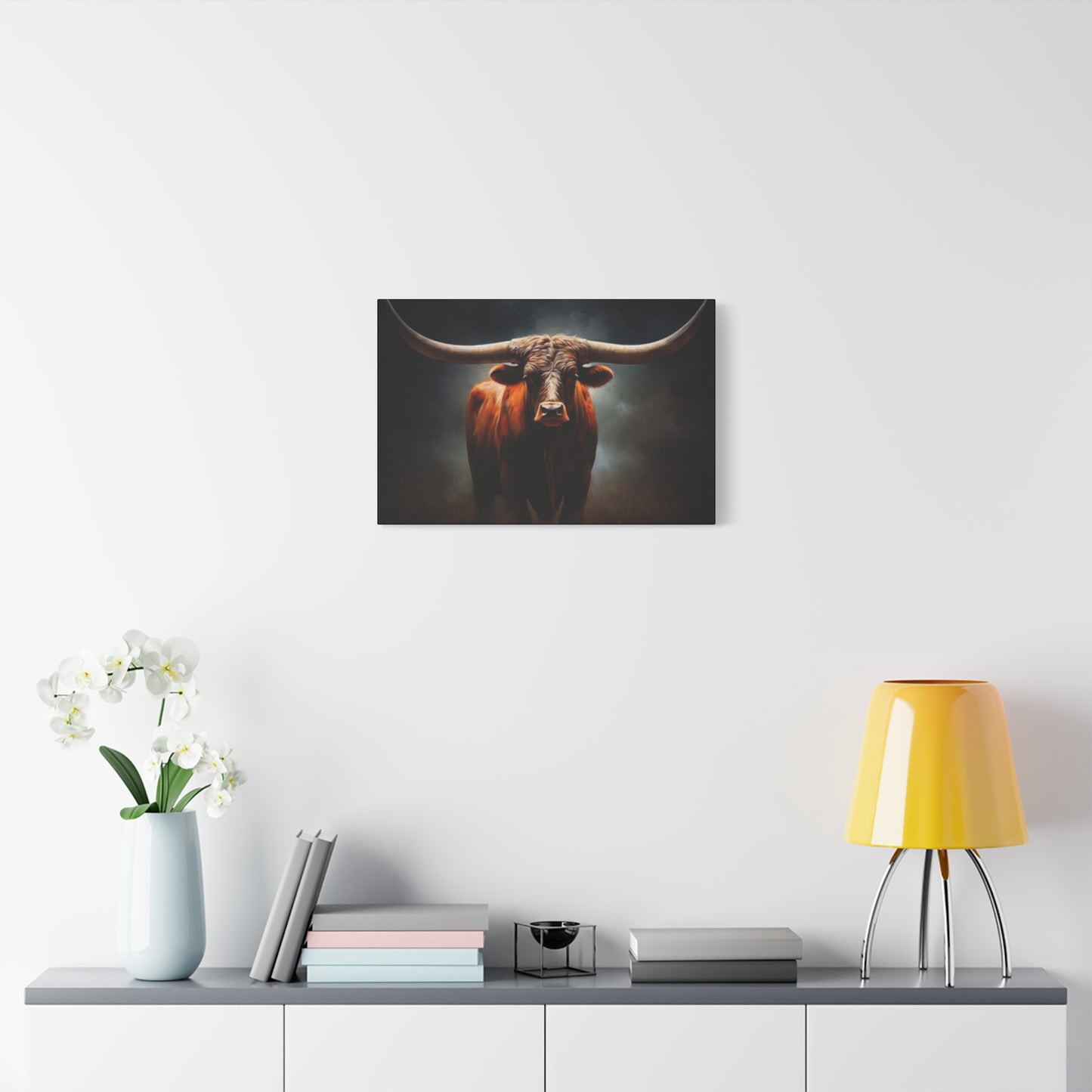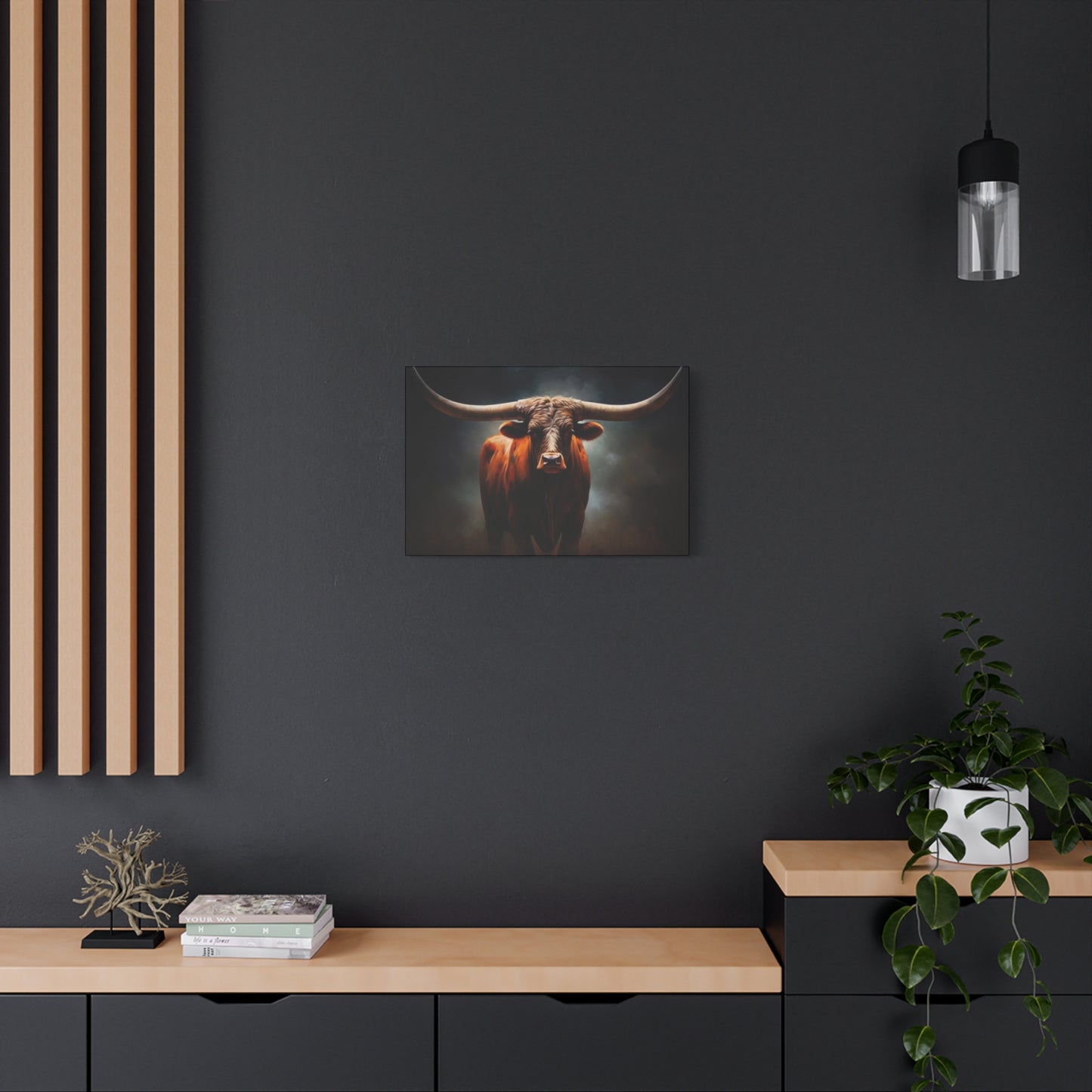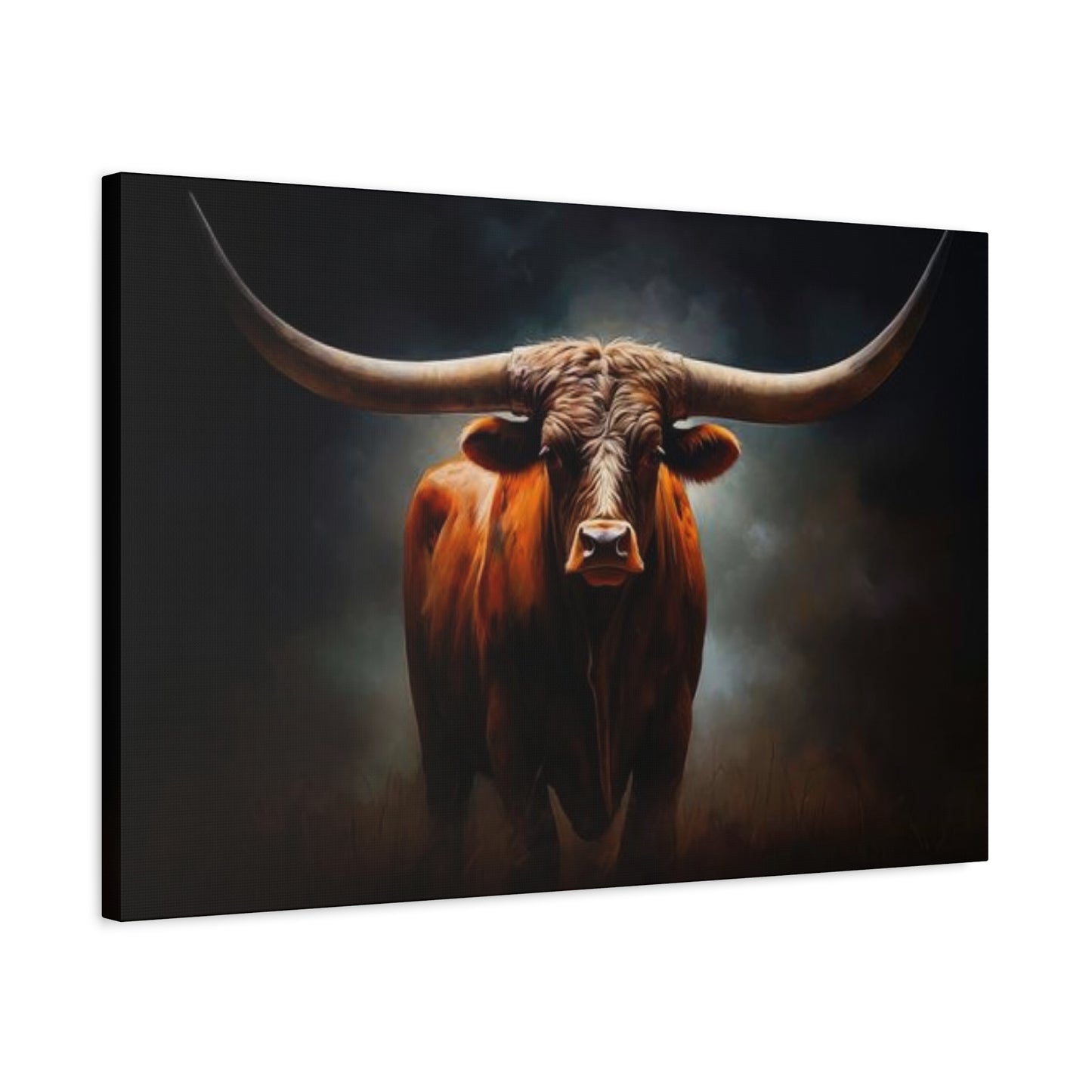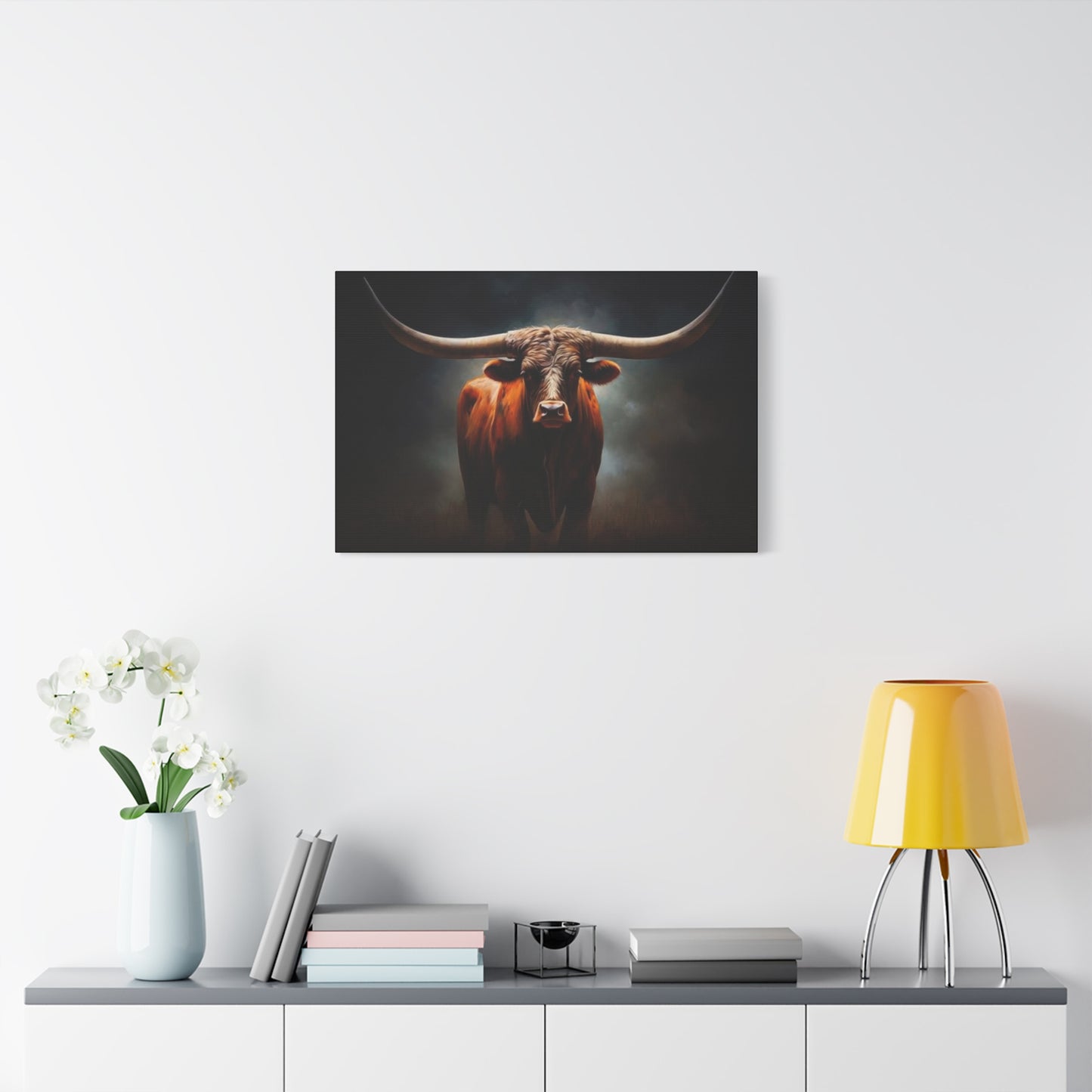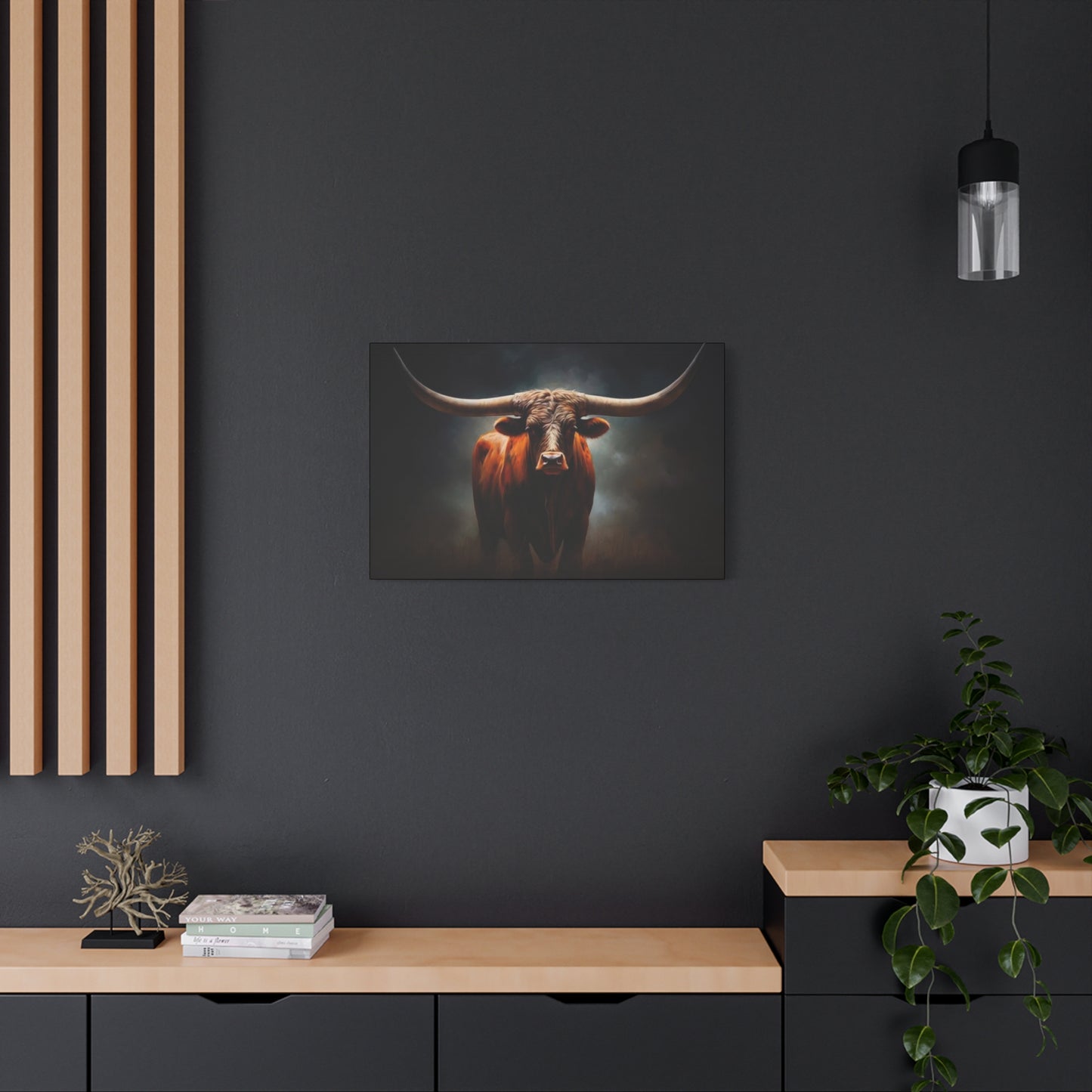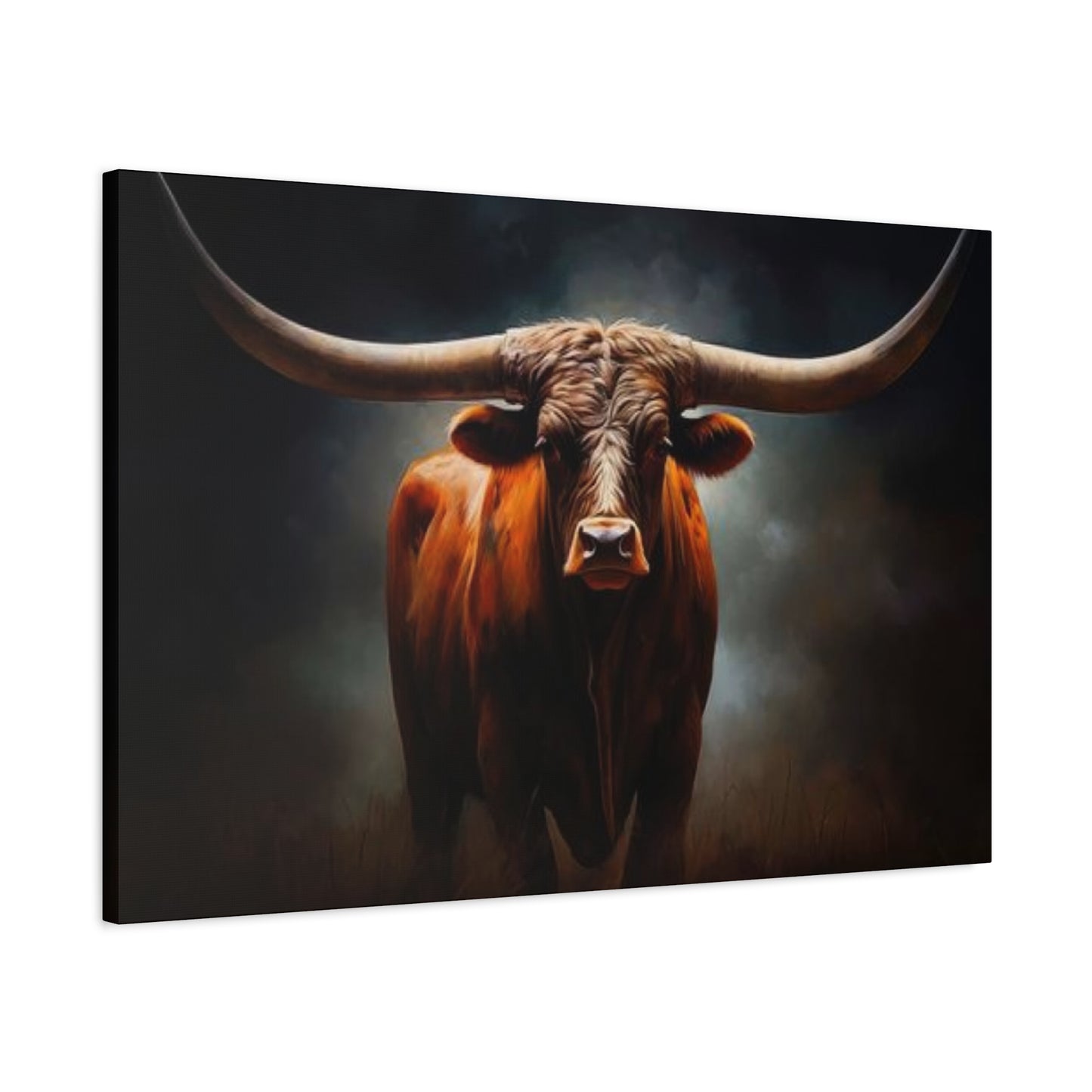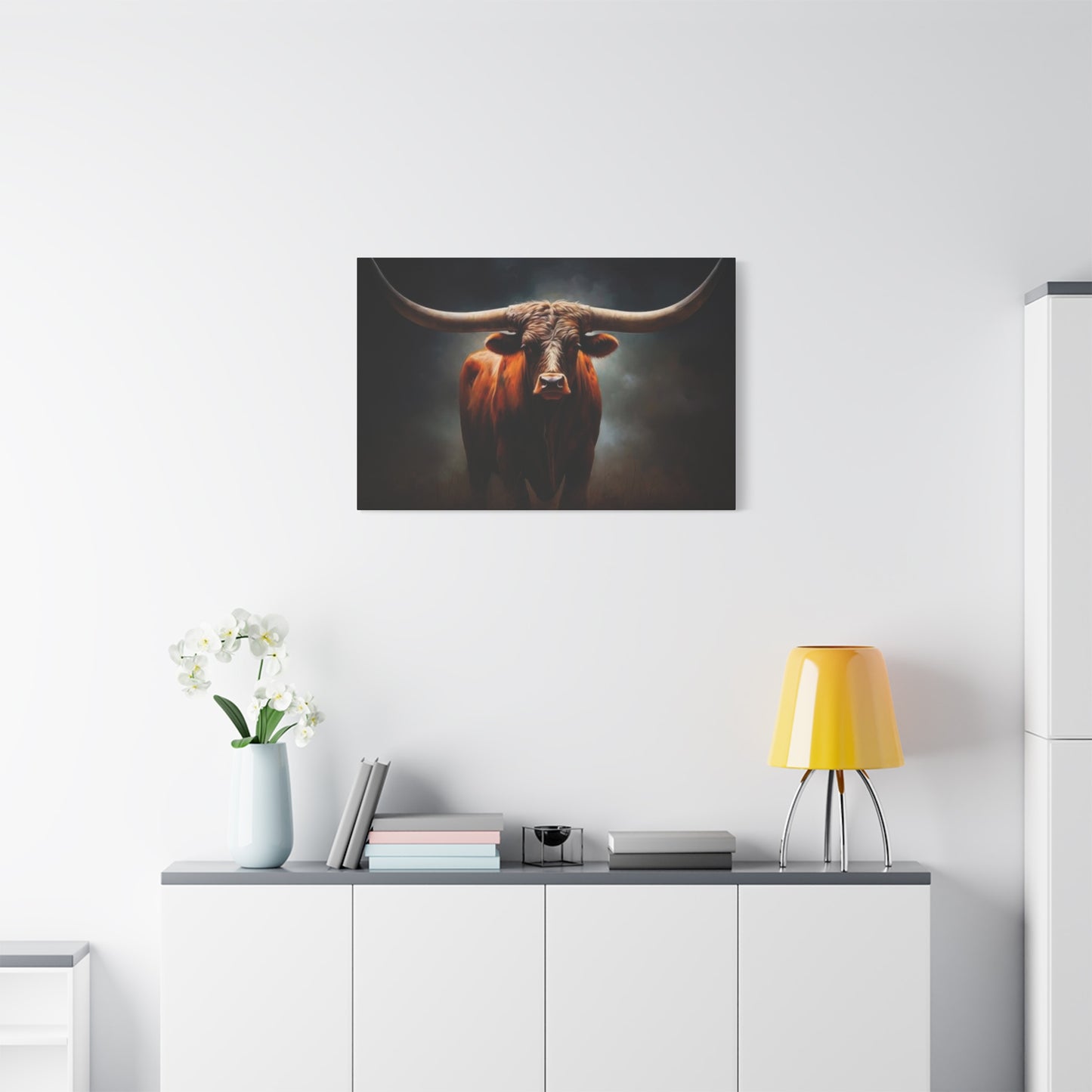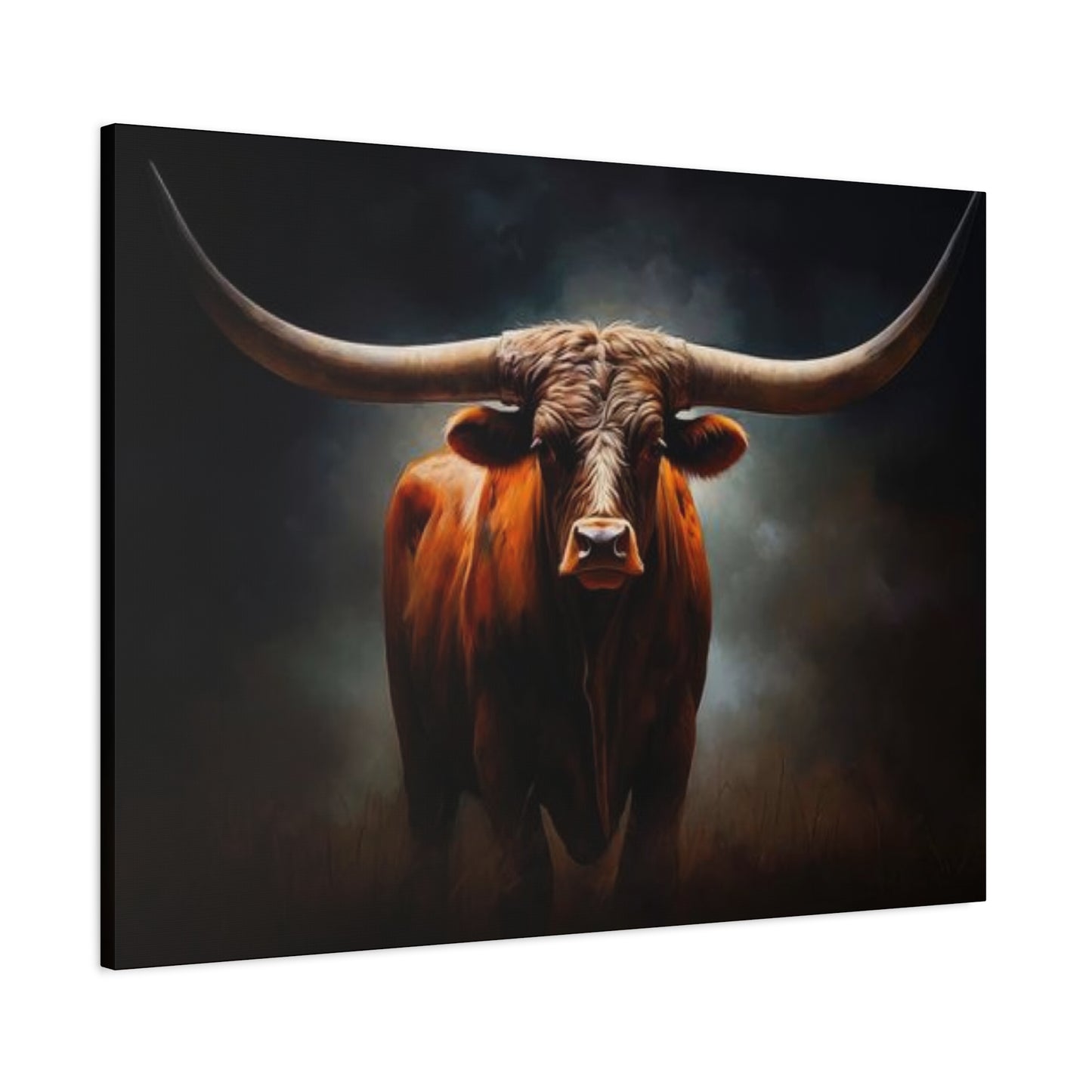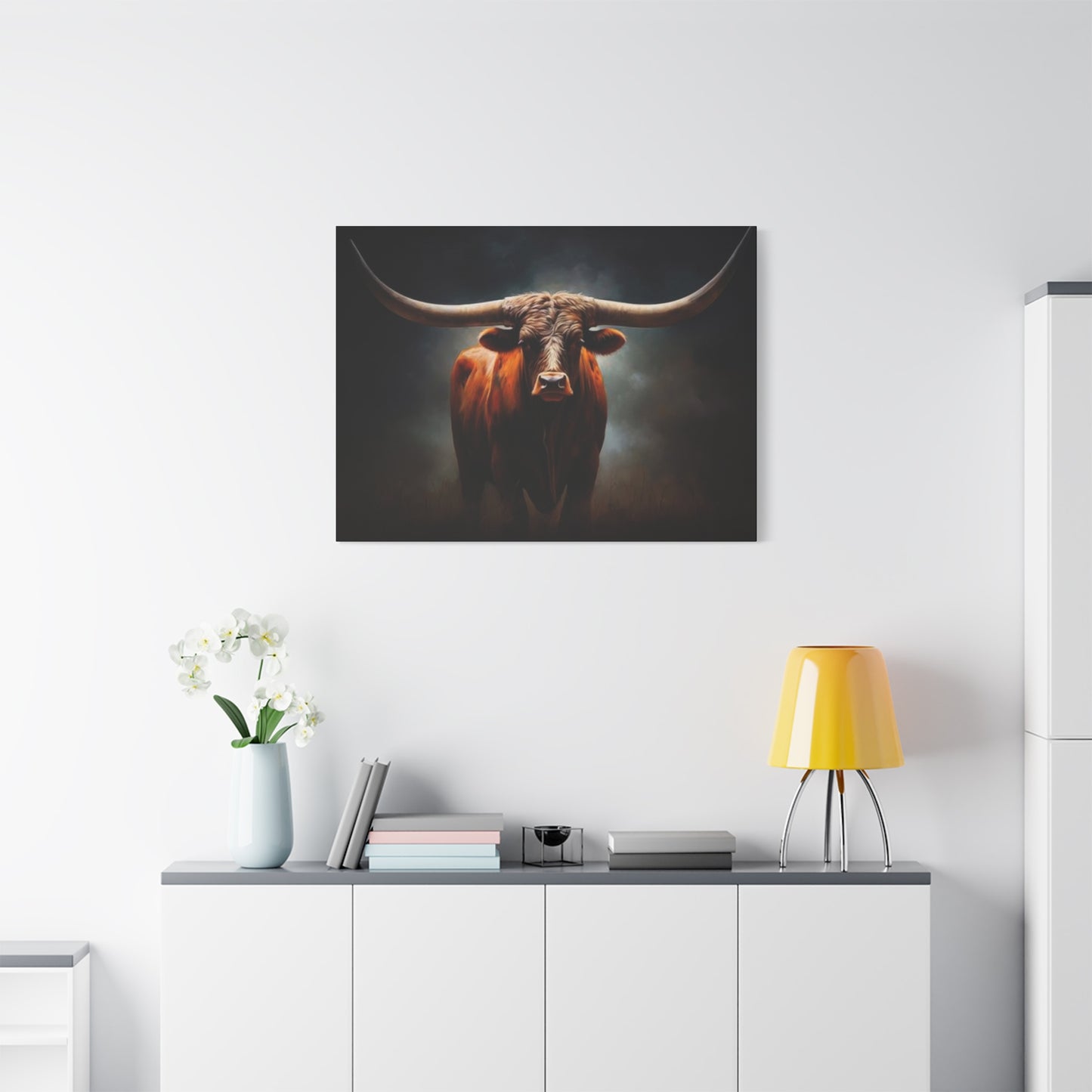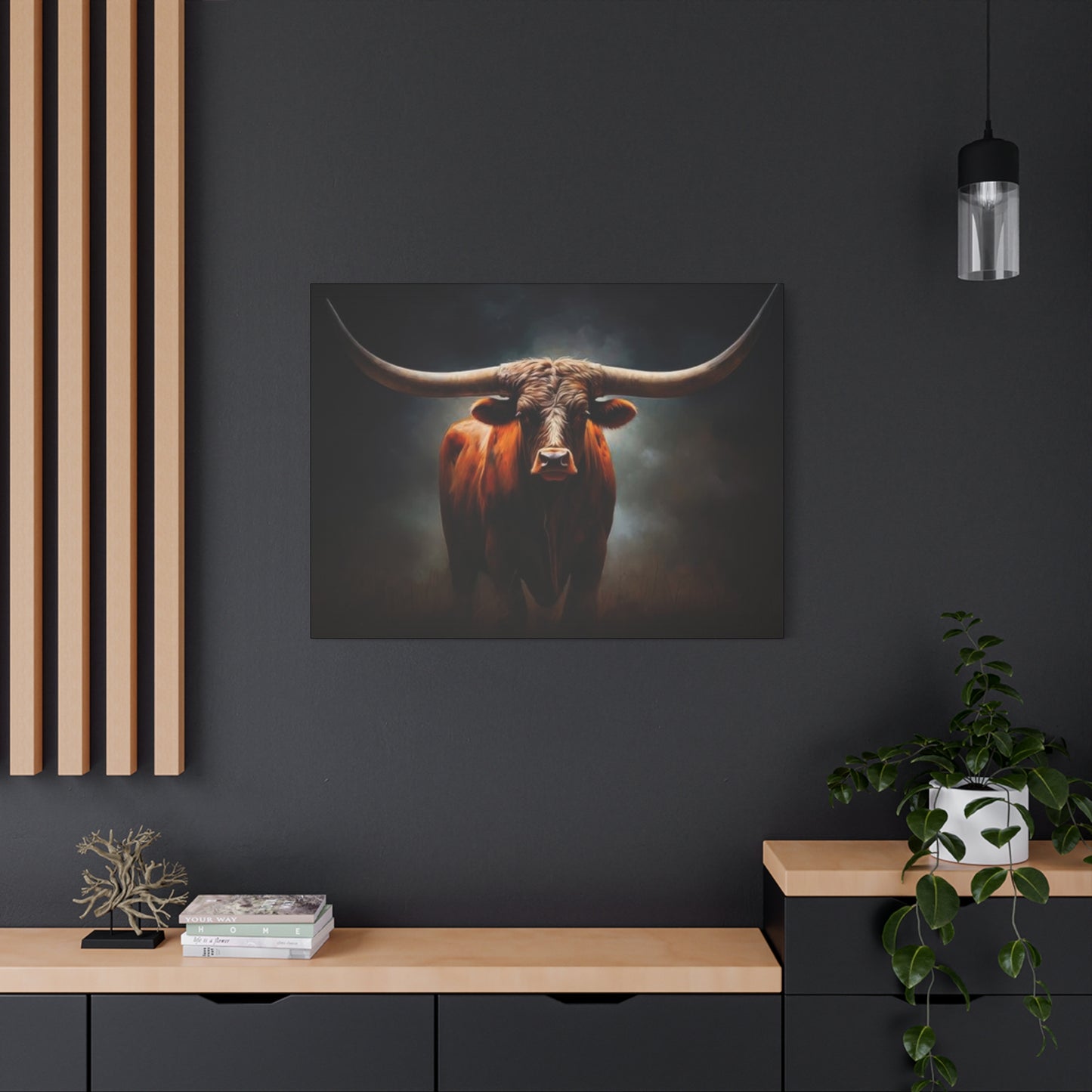Majestic Hairy Bull with Straight Long Horns Canvas Wall Art
The world of artistic expression has long been captivated by the magnificent presence of bulls, creating a rich tapestry of visual narratives that speak to our deepest connections with nature's most powerful creatures. Bull wall art represents far more than simple decorative elements; these pieces embody strength, resilience, and cultural significance that transcends mere aesthetic appeal. From ancient cave paintings to contemporary gallery exhibitions, the bovine form has consistently inspired artists to capture the essence of raw power and natural beauty.
The fascination with bull imagery stems from humanity's historical relationship with these remarkable animals. Throughout civilizations, bulls have represented fertility, strength, and divine power, making them perfect subjects for artistic interpretation. Modern homeowners increasingly recognize the profound impact that carefully selected bovine artwork can have on their living environments, creating focal points that command attention while conveying deeper symbolic meanings.
Contemporary bull wall art encompasses an extraordinary range of styles, techniques, and interpretations. Artists employ various mediums to capture the essence of these magnificent creatures, from traditional oil paintings that highlight every muscular detail to abstract representations that focus on emotional impact rather than literal depiction. The versatility of bull imagery allows for seamless integration into diverse decorative schemes, whether the goal is to create a rustic farmhouse atmosphere or establish a sophisticated modern aesthetic.
The psychological impact of bull imagery cannot be understated. These powerful animals evoke feelings of strength, determination, and unwavering resolve. When incorporated into home environments, bull wall art serves as daily reminders of personal power and the importance of standing firm in the face of challenges. The symbolic weight carried by these images makes them particularly meaningful choices for those seeking artwork that resonates on both visual and emotional levels.
Modern manufacturing techniques have revolutionized the accessibility of bull wall art. High-quality printing technologies allow for the reproduction of masterful works at affordable price points, while digital art platforms enable contemporary artists to reach global audiences with their bovine-inspired creations. This democratization of art has led to an explosion of available styles and price ranges, ensuring that every enthusiast can find pieces that align with their personal taste and budget constraints.
Straight Horns in Bull Art
The architectural marvel of straight bull horns has captivated artists for centuries, representing one of nature's most perfectly engineered weapons and tools. These magnificent projections serve as powerful focal points in artistic compositions, drawing the viewer's eye while conveying messages of strength and determination. Artists who specialize in depicting straight-horned bulls often emphasize the geometric precision of these natural formations, creating works that balance organic beauty with mathematical perfection.
The technical challenges involved in accurately rendering straight horns require exceptional skill and attention to detail. Artists must understand the complex relationship between light and shadow as it plays across the curved surfaces, while also capturing the subtle variations in texture that make each horn unique. The most successful pieces demonstrate mastery of perspective, ensuring that the horns appear to project naturally from the bull's head while maintaining proper proportional relationships with other facial features.
Contemporary interpretations of straight-horned bulls often explore the symbolic implications of these impressive appendages. In many cultures, horns represent connection between earthly and divine realms, making them powerful spiritual symbols. Artists leverage this symbolic weight to create pieces that speak to viewers on multiple levels, combining visual impact with deeper metaphysical meaning. The straight horn's unwavering trajectory toward the heavens reinforces themes of aspiration and spiritual growth.
Color theory plays a crucial role in effective straight horn depictions. Many artists choose to highlight these features using contrasting tones, ensuring that the horns stand out prominently against darker backgrounds. Others prefer subtle gradations that allow the horns to emerge naturally from surrounding elements. The choice of approach often depends on the overall compositional goals and the emotional impact the artist seeks to achieve.
The market for straight-horned bull art has experienced significant growth as collectors recognize the unique appeal of these focused compositions. Pieces that successfully capture the majesty of straight horns often command premium prices, particularly when created by established artists with proven track records. The combination of technical excellence and symbolic resonance makes these works particularly appealing to serious art enthusiasts and casual decorators alike.
Texture in Hairy Bull Drawings
The intricate world of bovine fur presents artists with extraordinary opportunities to demonstrate technical mastery while creating visually compelling textures that invite tactile exploration. Hairy bull drawings require patience, skill, and deep understanding of how different drawing mediums interact with paper surfaces to create convincing representations of natural fur patterns. The most accomplished artists develop personal techniques for rendering individual hairs while maintaining overall compositional coherence.
Graphite pencils remain the preferred medium for many artists working in this specialized area. The range of hardness available in modern pencil sets allows for incredible variation in line weight and texture creation. Artists typically begin with harder pencils to establish basic shapes and proportions, gradually building layers of softer graphite to achieve the rich, dark tones necessary for convincing fur representation. The process requires careful planning and methodical execution to avoid overworking areas that should remain light and airy.
Charcoal offers alternative approaches to capturing bovine fur textures. The medium's inherent properties allow for rapid coverage of large areas while maintaining the ability to create fine details through careful manipulation. Many artists appreciate charcoal's forgiving nature, which permits easy corrections and adjustments throughout the drawing process. The organic quality of charcoal seems particularly well-suited to natural subjects like hairy bulls, creating an aesthetic harmony between medium and subject matter.
Digital drawing tools have revolutionized texture creation in contemporary bull art. Sophisticated software packages offer brush options specifically designed to simulate natural fur patterns, allowing artists to achieve highly realistic results with greater efficiency than traditional methods. However, the most successful digital artists understand that technology alone cannot substitute for careful observation and understanding of actual fur structure and behavior.
The emotional impact of well-executed fur textures cannot be understated. Viewers often experience almost irresistible urges to reach out and touch artwork that successfully conveys the softness and warmth of animal fur. This tactile quality adds dimensions of engagement that purely smooth or geometric artworks cannot match. The investment of time and skill required to create convincing fur textures results in pieces that command attention and respect from viewers with varying levels of artistic knowledge.
Power of Straight Horns
The commanding presence of straight bull horns extends far beyond their obvious practical functions, serving as potent symbols of unwavering determination and focused intent. Artists who choose to emphasize these impressive features tap into archetypal imagery that resonates across cultural boundaries, creating works that speak to universal human experiences of strength and perseverance. The visual impact of perfectly straight horns cannot be replicated through artificial means, making authentic representations particularly valuable.
Historical analysis reveals that straight-horned bulls have been revered across numerous civilizations for their apparent supernatural qualities. Ancient artists often depicted these creatures as messengers of divine will or earthly manifestations of celestial power. Modern interpretations continue to explore these spiritual dimensions while adding contemporary psychological understanding of how geometric perfection affects human perception and emotional response.
The physics of straight horn formation fascinate both artists and scientists. These remarkable structures grow continuously throughout the animal's life, maintaining their linear trajectory through complex biological processes that ensure proper alignment and structural integrity. Artists who understand these natural mechanisms can create more convincing representations that capture both the visual appeal and underlying biological reality of straight horn development.
Compositional techniques for emphasizing horn power vary significantly among artists. Some prefer dramatic lighting that creates stark contrasts between the horns and surrounding elements, while others rely on careful positioning within the frame to maximize visual impact. The most effective approaches often combine multiple techniques, using lighting, color, and composition to create synergistic effects that amplify the inherent power of the straight horn form.
Market analysis indicates strong collector interest in artwork that successfully captures the power of straight horns. These pieces often serve as statement artwork in professional environments where themes of strength and determination align with organizational values. The universal appeal of these images transcends cultural boundaries, making them excellent choices for diverse settings and audiences.
Rustic Bull Wall Decor
The rustic aesthetic has experienced remarkable popularity growth as homeowners seek to create environments that feel authentic and connected to natural origins. Bull-themed rustic decor perfectly captures this desire, combining powerful animal imagery with materials and techniques that evoke simpler times and closer connections to agricultural life. The weathered, aged appearance characteristic of rustic styling adds narrative depth to bull imagery, suggesting stories of hard work and natural cycles.
Traditional rustic materials like reclaimed wood, aged metal, and natural fibers provide ideal foundations for bull-themed decorative pieces. Artists working in this style often embrace imperfections and irregularities that would be considered flaws in more refined approaches. The intentional inclusion of wear patterns, surface variations, and asymmetrical elements creates authentic rustic character that cannot be successfully imitated through artificial aging processes.
Color palettes in rustic bull decor typically emphasize earth tones and muted shades that reflect natural environmental conditions. Browns, tans, grays, and deep greens dominate these compositions, often accented with touches of rust orange or barn red. The restraint shown in color selection allows the powerful form of the bull to take center stage while ensuring that pieces integrate harmoniously with rustic decorative schemes.
Distressing techniques play crucial roles in creating authentic rustic appearances. Artists employ various methods to simulate years of weather exposure and natural aging, including strategic sanding, selective staining, and controlled oxidation processes. The goal is always to create surfaces that appear naturally aged rather than artificially treated, requiring careful judgment and extensive experience to achieve convincing results.
The versatility of rustic bull decor makes it suitable for numerous room types and decorative approaches. These pieces work equally well in traditional farmhouse kitchens, masculine den environments, and contemporary homes seeking to incorporate natural elements. The timeless appeal of rustic styling ensures that these investments retain their aesthetic value over time, making them practical choices for long-term home decoration strategies.
Bull Symbolism in Art
The profound symbolic significance of bulls in human culture creates rich interpretive opportunities for contemporary artists exploring themes of power, fertility, and spiritual connection. Throughout history, these magnificent creatures have represented divine strength, agricultural abundance, and the raw forces of nature that both threaten and sustain human civilization. Modern artistic interpretations continue to explore these ancient symbols while adding contemporary psychological and social perspectives.
Mythological traditions from around the world feature bulls as central figures in creation stories, heroic adventures, and spiritual teachings. The Minoan bull-leaping ceremonies, Celtic bull cults, and Hindu reverence for sacred cattle demonstrate the universal human fascination with bovine power and symbolism. Contemporary artists draw upon these rich traditions while creating works that speak to modern audiences facing different but equally challenging circumstances.
Jungian psychology provides fascinating frameworks for understanding bull symbolism in art. The archetype of the bull represents masculine power, creative force, and the untamed aspects of human nature that civilization attempts to control or channel. Artists who understand these psychological dimensions can create works that resonate on subconscious levels, triggering emotional responses that viewers may not fully understand but nevertheless find compelling.
Color symbolism adds additional layers of meaning to bull artwork. Black bulls often represent mystery, death, or hidden knowledge, while white bulls suggest purity, spiritual enlightenment, or divine intervention. Red bulls embody passion, anger, or life force energy. Artists who skillfully employ color symbolism can communicate complex ideas without relying on obvious visual narratives or explicit symbolic elements.
The commercial appeal of symbolically rich bull artwork reflects widespread human desire for meaningful decoration that transcends mere aesthetic pleasure. Collectors increasingly seek pieces that offer emotional and intellectual engagement alongside visual appeal. This trend has created market opportunities for artists who can successfully combine technical skill with deep understanding of symbolic traditions and contemporary psychological insights.
Majestic Hairy Bulls
The awe-inspiring presence of bulls adorned with thick, luxurious coats creates artistic opportunities that combine technical challenges with emotional impact. These magnificent creatures, often found in highland regions or cold climates, develop impressive fur coverings that transform their appearance from merely powerful to absolutely majestic. Artists who specialize in depicting hairy bulls must master complex texture rendering techniques while capturing the dignity and presence that characterize these remarkable animals.
Highland cattle breeds provide particularly striking subjects for artistic interpretation. Their long, flowing hair creates dramatic silhouettes that seem to blur the boundaries between animal and mythical creature. The way light plays through and across these flowing locks requires sophisticated understanding of both optical physics and artistic technique. Successful renditions often take weeks or months to complete, as artists carefully build layers of texture that convincingly represent thousands of individual hairs.
Weather conditions significantly influence the appearance of hairy bull coats, creating seasonal variations that artists can exploit for dramatic effect. Winter coats reach maximum density and length, creating almost surreal appearances that challenge viewers' expectations of typical bovine forms. Spring shedding periods produce interesting contrast patterns as older, longer hair mingles with newer, shorter growth. Artists who understand these natural cycles can create more authentic and emotionally resonant works.
Photographic reference materials play crucial roles in successful hairy bull artwork creation. The complexity of fur patterns makes accurate memory-based rendering nearly impossible, requiring artists to work from high-quality photographs that capture subtle variations in hair direction, density, and color. The best reference materials show subjects under various lighting conditions, providing artists with comprehensive information needed for convincing artistic interpretation.
The market for majestic hairy bull artwork has expanded significantly as collectors recognize the unique appeal of these challenging subjects. Pieces that successfully capture the full impact of impressive bovine coats often command premium prices, reflecting both the technical difficulty involved and the emotional response these images generate. The combination of natural majesty and artistic skill creates viewing experiences that few other subjects can match.
Detail in Bull Horn Art
The extraordinary complexity found in bull horn structure provides artists with endless opportunities for detailed exploration and technical demonstration. These remarkable appendages feature intricate surface patterns, subtle color variations, and complex three-dimensional forms that challenge even the most skilled artists. The level of detail possible in horn-focused artwork often determines the difference between amateur attempts and professional masterpieces that command serious collector attention.
Surface texture analysis reveals that bull horns possess unique characteristics that vary by breed, age, and environmental conditions. Young horns display smooth, almost polished appearances, while mature specimens develop complex ridge patterns and weathering marks that tell stories of the animal's life experiences. Artists who understand these natural progression patterns can create age-appropriate representations that enhance the believability and emotional impact of their work.
Light behavior on horn surfaces creates fascinating artistic challenges. The semi-translucent quality of horn material allows for subtle internal illumination effects that are difficult to achieve through traditional painting techniques. Many artists develop specialized approaches for capturing these unique optical properties, often employing multiple glaze layers or careful color mixing to approximate the complex interaction between light and horn material.
Microscopic examination of horn surfaces reveals incredible detail levels that can inspire highly realistic artistic approaches. The presence of growth rings, similar to tree rings, provides information about the animal's developmental history. Wear patterns show evidence of environmental interaction and behavioral habits. Artists who incorporate these subtle details create works that reward close examination while maintaining impact when viewed from normal distances.
The technical demands of detailed horn rendering make these works particularly appealing to collectors who appreciate artistic skill and dedication. Pieces that demonstrate exceptional attention to horn detail often become centerpieces in serious collections, representing the highest levels of contemporary animal art achievement. The time investment required for such detailed work ensures that these pieces remain relatively rare and highly valued in the art market.
Framing Bull Wall Art
The presentation of bull artwork through appropriate framing choices dramatically influences both visual impact and longevity of these powerful pieces. Professional framing decisions require careful consideration of the artwork's style, the intended display environment, and the long-term preservation requirements of different artistic media. The frame becomes an integral part of the overall aesthetic experience, either enhancing the artwork's impact or detracting from its intended effect.
Traditional frame materials like solid wood offer timeless appeal that complements the natural subject matter of bull artwork. Oak, pine, and other hardwoods provide sturdy, attractive options that age gracefully while protecting valuable artwork from environmental damage. The natural grain patterns in wood frames create subtle visual interest that enhances rather than competes with the main artistic elements. Different wood species offer various color tones and texture options to match specific decorative schemes.
Metal framing options provide contemporary alternatives that work particularly well with modern bull art interpretations. Brushed aluminum, steel, and bronze frames offer clean lines and industrial aesthetics that complement abstract or minimalist bovine artwork. The durability of metal frames makes them excellent choices for high-traffic areas or environments where moisture resistance is important. Custom metal frames can be powder-coated in virtually any color to match specific decorative requirements.
Matting decisions significantly influence the visual presentation of bull artwork. Wide mats create breathing room around images, allowing viewers to focus on artistic details without distraction. Narrow mats maintain intimate connections between artwork and frames while providing necessary separation from glass surfaces. Color selection for matting materials should complement both the artwork and frame while avoiding combinations that draw attention away from the main subject.
Professional glazing options protect artwork while minimizing visual interference. Museum-quality glass eliminates ultraviolet radiation that can fade artwork over time while providing crystal-clear viewing experiences. Anti-reflective coatings reduce glare in bright environments, ensuring that artwork remains clearly visible throughout different lighting conditions. The investment in quality glazing materials pays dividends through extended artwork life and enhanced viewing pleasure.
Straight Horns and Strength
The unwavering trajectory of straight bull horns serves as a powerful metaphor for focused determination and uncompromising strength in the face of adversity. Artists who choose to emphasize this connection between physical form and psychological qualities tap into deep human understanding of how external appearance reflects internal character. The visual impact of perfectly aligned horns creates immediate associations with concepts of purpose, direction, and unwavering resolve.
Biomechanical analysis reveals that straight horns represent optimal engineering solutions for both offensive and defensive functions. The linear structure provides maximum strength-to-weight ratios while minimizing material requirements. This efficiency of design appeals to viewers on both conscious and subconscious levels, creating appreciation for natural problem-solving that transcends simple aesthetic enjoyment. Artists who understand these mechanical principles can create more convincing and impactful representations.
Psychological studies demonstrate that geometric regularity in natural forms triggers positive emotional responses in human observers. The perfect symmetry and linear progression of straight horns activate neural pathways associated with order, stability, and predictability. These unconscious responses enhance the emotional impact of artwork featuring prominently displayed straight horns, creating viewing experiences that feel satisfying even when viewers cannot articulate specific reasons for their positive reactions.
Cultural interpretations of straight horn symbolism vary across different societies but consistently emphasize themes of strength and determination. Native American traditions often associate straight horns with spiritual power and connection to natural forces. European folklore links these features to nobility and royal authority. Asian cultures may interpret straight horns as symbols of prosperity and good fortune. Artists who understand these cultural associations can create works that resonate with diverse audiences.
The market value of artwork emphasizing straight horn strength reflects widespread appreciation for these symbolic and aesthetic qualities. Collectors often seek pieces that convey messages of personal empowerment and resilience, making strength-themed bull art particularly appealing during challenging economic or social periods. The timeless nature of these themes ensures that such artwork maintains relevance and value over extended periods.
Bulls in Cultural Art
The rich tapestry of bull representation across diverse cultural traditions provides contemporary artists with an extraordinary reservoir of symbolic meaning and aesthetic inspiration. From ancient Mesopotamian cylinder seals to Spanish bullfighting posters, bovine imagery has consistently served as a vehicle for expressing cultural values, religious beliefs, and social aspirations. Modern artists who understand these historical precedents can create works that dialogue with tradition while addressing contemporary concerns.
Mediterranean cultures have particularly strong traditions of bull representation in art. The famous Minoan bull-leaping frescoes from Knossos demonstrate sophisticated artistic techniques applied to dynamic bovine subjects over 3,500 years ago. These ancient works continue to influence contemporary artists seeking to capture the kinetic energy and athletic grace of bulls in motion. The enduring appeal of these classical representations speaks to universal human fascination with bovine power and beauty.
Asian artistic traditions offer unique perspectives on bull symbolism and representation. Chinese zodiac traditions celebrate the ox as a symbol of hard work, reliability, and methodical progress toward goals. Japanese artistic interpretations often emphasize the spiritual dimensions of bovine presence, incorporating Buddhist concepts of patience and gentle strength. Indian artistic traditions reverence cattle as sacred beings worthy of worship and protection, creating artistic approaches that emphasize divine rather than merely physical qualities.
African artistic traditions contribute distinctive stylistic approaches to bull representation that emphasize pattern, rhythm, and cultural storytelling. Traditional masks and sculptures often abstract bovine forms into geometric patterns that capture essential spiritual qualities rather than literal physical appearances. These approaches offer contemporary artists alternative methods for expressing bull-related themes while creating visually striking and culturally meaningful artwork.
Contemporary global art markets demonstrate strong appreciation for culturally informed bull artwork that successfully bridges traditional and modern approaches. Collectors increasingly value pieces that demonstrate deep understanding of cultural context while addressing universal human experiences. Artists who can successfully navigate these complex requirements often develop international reputations and command premium prices for their culturally sophisticated works.
Black & White Bull Art
The stark contrast and timeless elegance of monochromatic bull artwork creates dramatic visual impact that transcends the limitations of color-based compositions. Black and white artistic approaches force viewers to focus on essential elements like form, texture, and emotional expression rather than being distracted by chromatic considerations. This artistic restraint often results in more powerful and memorable viewing experiences that demonstrate the fundamental strength of well-conceived bovine imagery.
Photographic traditions in black and white bull art establish high standards for contemporary artistic interpretations. Master photographers like Ansel Adams and Edward Weston demonstrated how monochromatic approaches could reveal subtle tonal relationships and textural details that color photography might obscure. Modern artists working in traditional media draw inspiration from these photographic achievements while adapting techniques to their chosen artistic mediums and personal expressive goals.
Tonal range management becomes crucial in successful black and white bull art. Artists must carefully control the relationship between the darkest darks and lightest lights to maintain visual interest throughout the composition. The absence of color requires more sophisticated understanding of value relationships and how different gray tones interact to create depth, volume, and atmospheric effects. Master artists often spend years developing the sensitivity required for effective monochromatic composition.
High contrast approaches in black and white bull art create dramatic, graphic effects that work particularly well in contemporary decorative schemes. These bold presentations reduce complex bovine forms to essential elements while maximizing visual impact. The elimination of intermediate gray tones forces artists to make decisive choices about which details to include and which to sacrifice for overall compositional effectiveness.
Contemporary digital tools have revolutionized black and white bull art creation while also creating new challenges for artists seeking authentic monochromatic aesthetics. Computer software can easily convert color images to black and white, but achieving truly effective monochromatic compositions requires artistic judgment that cannot be automated. The most successful digital artists understand traditional black and white principles while leveraging technology to achieve effects that would be difficult or impossible through conventional means.
Minimalist Bull Drawings
The philosophy of minimalism applied to bull artwork creates unique challenges and opportunities for artists seeking to capture bovine essence through simplified visual means. Successful minimalist approaches require deep understanding of what elements are truly essential for conveying the strength, presence, and character that make bull imagery compelling. The process of reduction forces artists to identify core qualities that remain impactful even when decorative details are eliminated.
Line economy becomes paramount in minimalist bull drawings. Every mark must serve multiple purposes, contributing to form description, texture suggestion, and emotional expression simultaneously. Artists working in this demanding style often spend considerable time experimenting with different linear approaches before identifying solutions that achieve maximum impact through minimum means. The resulting drawings often possess clarity and directness that more complex approaches cannot match.
Negative space utilization offers powerful tools for minimalist bull artists. The areas around and between drawn elements become active compositional participants rather than empty backgrounds. Skilled artists use negative space to suggest volume, create movement, and establish relationships between different drawing elements. This sophisticated understanding of spatial relationships distinguishes professional minimalist work from amateur attempts at simplified drawing.
Contemporary minimalist bull art appeals to collectors and decorators seeking sophisticated visual solutions for modern environments. These pieces often integrate seamlessly into architectural settings where busy or complex artwork might compete with structural elements or furniture. The timeless quality of minimalist approaches ensures that these investments remain stylistically relevant despite changing decorative trends.
Digital tools have expanded possibilities for minimalist bull art while also creating new aesthetic challenges. Vector graphics software enables precise line control and easy experimentation with different approaches to simplification. However, the clinical perfection possible through digital means can lack the human quality that makes traditional minimalist drawings emotionally engaging. The most successful digital minimalists understand how to introduce subtle irregularities that maintain human connection while leveraging technological precision.
Animal Texture in Art
The complex challenge of accurately rendering animal textures in artistic compositions requires deep observation skills, technical mastery, and understanding of how different materials interact with light and shadow. Bull artwork particularly benefits from convincing texture representation, as these powerful animals possess rich surface qualities that contribute significantly to their visual impact and emotional presence. Artists who master texture rendering techniques can create works that engage viewers on both visual and tactile levels.
Fur rendering techniques vary dramatically depending on the artistic medium and desired aesthetic effect. Oil painting allows for subtle color variations and smooth transitions that can convincingly represent the complex interplay of individual hairs, underlying skin tones, and environmental lighting. Watercolor approaches often emphasize the fluidity and organic quality of animal textures through careful wet-in-wet techniques and strategic dry brush applications.
Layering strategies prove essential for building convincing animal textures in any medium. Artists typically begin with broad undertones that establish overall color relationships and basic form, then gradually add successive layers of detail that build toward final surface textures. This methodical approach prevents overworking while ensuring that each layer contributes meaningfully to the final textural effect.
Reference material quality significantly influences texture rendering success. High-resolution photographs that clearly show surface details, hair direction patterns, and lighting effects provide essential information for accurate artistic interpretation. Many professional animal artists maintain extensive reference libraries organized by species, coat types, and lighting conditions to support their artistic work.
The emotional impact of well-executed animal textures cannot be understated. Viewers often experience almost irresistible desires to touch artwork that successfully conveys the softness, warmth, or roughness of animal surfaces. This tactile quality creates deeper engagement levels than purely smooth or geometric compositions can achieve, making texture mastery a valuable skill for artists seeking to create memorable and impactful animal artwork.
Modern Bull Art Styles
Contemporary artistic movements have profoundly influenced bull art creation, resulting in diverse stylistic approaches that range from photorealistic representation to abstract expressionist interpretation. Modern artists working with bovine subjects draw inspiration from various sources while developing personal aesthetic languages that reflect current cultural concerns and artistic innovations. The result is an unprecedented diversity of bull art styles that offer something for every taste and decorative requirement.
Abstract expressionist approaches to bull art emphasize emotional content over literal representation. Artists working in this style use bovine forms as starting points for explorations of color, gesture, and psychological expression. The power and presence associated with bulls provide perfect foundations for dramatic, emotionally charged compositions that prioritize feeling over description. These works often achieve their impact through bold brushwork, dynamic compositions, and expressive color choices rather than accurate anatomical rendering.
Pop art influences have created bull artwork that comments on consumer culture, mass media, and contemporary social issues. Artists working in this tradition often employ bright colors, commercial imagery techniques, and cultural references that transform traditional animal subjects into vehicles for social commentary. The familiar form of the bull provides recognizable imagery that viewers can easily relate to while artists layer additional meanings through stylistic choices and contextual references.
Photorealistic approaches represent the opposite extreme from abstract interpretation, focusing on technical excellence and optical accuracy. Artists working in this demanding style often spend months creating single pieces that rival photography in their attention to detail and surface accuracy. The challenge lies not just in technical execution but in creating compositions that transcend mere copying to achieve genuine artistic impact.
Mixed media approaches combine various materials and techniques to create unique aesthetic effects impossible through single-medium applications. Contemporary bull artists experiment with combinations of traditional painting, collage elements, digital imagery, and sculptural components to create works that challenge conventional definitions of drawing and painting. These innovative approaches often result in highly original and visually striking pieces that stand out in increasingly crowded art markets.
Realistic Bull Horn Art
The pursuit of absolute realism in bull horn representation represents one of the most technically demanding challenges in contemporary animal art. These complex three-dimensional forms require sophisticated understanding of perspective, surface texture, light behavior, and material properties to achieve convincing artistic results. Artists who master realistic horn rendering often develop specialized techniques and approaches that become signature elements in their artistic practice.
Anatomical accuracy forms the foundation of successful realistic horn art. Artists must understand the underlying bone structure, growth patterns, and surface characteristics that give horns their distinctive appearance. This knowledge enables creation of believable forms that maintain accuracy even when viewed from unusual angles or under dramatic lighting conditions. Many professional animal artists study veterinary texts and examine actual horn specimens to develop this essential understanding.
Surface texture complexity in horn material creates numerous artistic challenges. The semi-translucent quality allows for subtle internal light effects, while surface irregularities create complex shadow patterns. Growth rings, wear marks, and color variations add additional layers of visual information that must be accurately captured for convincing realism. Artists often develop personal techniques for representing these various textural elements while maintaining overall compositional unity.
Color mixing for realistic horn representation requires subtle understanding of how various pigments interact to create natural-looking results. Horn colors rarely consist of single hues but rather complex mixtures that change subtly across the surface in response to lighting conditions and underlying structural variations. Master artists often mix dozens of different color combinations to achieve the subtle gradations necessary for convincing horn realism.
The market for realistic bull horn art reflects appreciation for technical excellence and artistic dedication. Collectors who value craftsmanship and skill often specifically seek hyperrealistic pieces that demonstrate exceptional artistic ability. These works often serve as showcase pieces in serious collections, representing the highest levels of contemporary animal art achievement.
Abstract Bull Wall Art
The liberation from literal representation inherent in abstract approaches to bull artwork opens unlimited creative possibilities while challenging artists to capture bovine essence through purely visual means. Abstract bull art succeeds when artists identify fundamental qualities that make bulls compelling subjects and find ways to express these characteristics through color, form, line, and composition rather than detailed description. The results often achieve emotional impact that exceeds what realistic representation might accomplish.
Geometric abstraction applied to bull subjects often emphasizes the angular, powerful qualities that characterize these impressive animals. Artists working in this style reduce complex organic forms to essential geometric elements while maintaining enough visual connection to suggest the original inspiration. Triangle shapes might represent horns, rectangular forms could suggest body mass, and dynamic diagonal lines might convey movement or energy. The challenge lies in achieving recognition while maintaining abstract integrity.
Color field approaches to bull abstraction focus on emotional and psychological associations rather than descriptive accuracy. Deep browns might evoke earth connections, bold reds could suggest power and passion, while black compositions might emphasize mystery or primal force. Artists working in this style rely on viewers' subconscious color associations to communicate ideas about bull characteristics without resorting to representational imagery.
Expressionist abstraction allows for highly personal interpretations of bull subjects that prioritize artist emotion over external accuracy. Vigorous brushwork, dynamic compositions, and expressive color choices create viewing experiences that engage emotions directly rather than through intellectual recognition. These works often achieve their impact through pure visual energy rather than subject matter familiarity.
Contemporary abstract bull art appeals to collectors seeking sophisticated visual solutions that provide ongoing discovery potential. Unlike representational works that reveal all their information immediately, successful abstract pieces continue to offer new insights and emotional responses over time. This quality of sustainable engagement makes abstract bull art particularly valuable for long-term collection strategies.
DIY Hairy Bull Drawings
The challenge of creating convincing hairy bull artwork through do-it-yourself approaches requires patience, observation skills, and willingness to experiment with various techniques until satisfactory results are achieved. Beginning artists often feel intimidated by the complexity of fur texture, but systematic approaches and persistent practice can lead to surprisingly successful results even without formal artistic training. The key lies in understanding that fur consists of thousands of individual elements that collectively create overall textural effects.
Basic material selection significantly influences DIY success potential. Quality drawing pencils in various hardness grades provide essential tools for building convincing fur textures. 2H pencils work well for initial sketching and light fur areas, while 4B or 6B pencils create the dark tones necessary for shadow areas and depth. Blending tools like tortillons or tissue paper help create smooth transitions between different textural areas.
Layering techniques form the foundation of successful DIY fur rendering. Beginning with light overall tones that establish basic form and shadow patterns, artists gradually build subsequent layers that add detail and surface texture. Each layer should be lighter and more specific than the previous one, working from general impressions toward specific details. This methodical approach prevents overworking while ensuring steady progress toward convincing results.
Reference photo utilization becomes crucial for DIY success. High-quality images that clearly show fur direction, density variations, and lighting effects provide essential guidance for accurate artistic interpretation. Beginning artists should choose reference photos with clear, dramatic lighting that simplifies shadow patterns and makes fur structure easy to understand. Complex or poorly lit references often lead to confusion and unsatisfactory results.
Practice strategies that focus on small sections rather than complete drawings help build confidence and skill before attempting major compositions. Creating studies of ear textures, forehead patterns, or neck areas allows for concentrated learning without the pressure of completing entire artworks. These practice sessions often produce valuable insights that dramatically improve subsequent attempts at complete drawings.
Emotional Impact of Bulls
The profound emotional response triggered by well-executed bull imagery stems from deep psychological associations between these powerful animals and fundamental human experiences of strength, struggle, and survival. Artists who understand these unconscious connections can create works that resonate on levels far deeper than simple visual appreciation. The emotional impact of bull art often exceeds what viewers expect, creating lasting impressions that influence their relationship with the artwork over time.
Archetypal psychology provides frameworks for understanding why bull imagery generates such strong emotional responses. Carl Jung's theories about collective unconscious suggest that certain animal forms trigger universal human responses that transcend individual cultural experiences. Bulls, with their associations to power, fertility, and natural force, activate archetypal patterns that connect viewers to primal aspects of human experience.
Fear and fascination combine in complex ways when viewers encounter powerful bull imagery. The obvious physical strength and potential danger represented by these animals creates tension that many find simultaneously thrilling and unsettling. Artists who skillfully navigate this emotional complexity can create works that hold viewers' attention while generating sustained emotional engagement rather than simple aesthetic appreciation.
Protective instincts often emerge in response to bull artwork, particularly pieces that depict young animals or family groups. The maternal qualities displayed by many bull breeds trigger nurturing responses that create emotional connections between viewers and artwork. These protective feelings often translate into strong attachment to specific pieces and reluctance to part with them once acquired.
Admiration for natural power and dignity represents another significant emotional response to bull art. Viewers often express appreciation for the honest, straightforward nature they perceive in bull imagery. Unlike human subjects that might trigger complex social responses, bulls appear to embody uncomplicated strength and authenticity that many people find refreshing and emotionally satisfying.
Bulls as Resilience Symbols
The extraordinary capacity of bulls to endure hardship while maintaining strength and dignity has made them powerful symbols of resilience across numerous cultures and contexts. These remarkable animals demonstrate ability to thrive in challenging environments, recover from setbacks, and maintain their essential nature despite external pressures. Artists who tap into this symbolic dimension create works that speak to viewers facing their own challenges and seeking inspiration for perseverance.
Historical examples of bull resilience provide compelling source material for contemporary artistic interpretation. Working bulls that spent lifetimes in agricultural labor while maintaining health and spirit offer models of sustained effort and dedication. Wild bulls that survived harsh seasons, predator threats, and environmental changes demonstrate natural resilience that many humans find inspiring. These historical narratives add depth and authenticity to resilience-themed artwork.
Psychological research supports the effectiveness of animal symbols in promoting human resilience and recovery from trauma or setbacks. The visual presence of strong, enduring animals can trigger positive mental associations that support emotional healing and personal growth. Therapists and counselors increasingly recognize the value of carefully chosen animal imagery in clinical settings where clients benefit from symbolic reinforcement of their own strength and capability.
Conclusion
The Majestic Hairy Bull with Straight Long Horns canvas wall art is more than a striking piece of décor—it’s a bold declaration of strength, natural beauty, and timeless rural symbolism. With its powerful presence and rugged elegance, this artwork captures the essence of the untamed, the noble, and the enduring spirit of nature. Whether displayed in a modern loft, rustic cabin, or farmhouse-inspired living space, this majestic bull becomes an instant focal point that commands attention and evokes admiration.
The bull—especially depicted with long, straight horns and a thick, textured coat—is a powerful symbol across cultures. It represents masculinity, courage, leadership, and resilience. In this artwork, the hairy texture of the bull's coat adds a layer of wild authenticity, emphasizing its raw, natural strength. The straight horns extend with purpose and symmetry, reinforcing a sense of balance and direction—qualities that translate beautifully into any space seeking grounding energy and bold character.
Artistically, the composition of this canvas blends realism with striking contrast. The detailed rendering of the bull's features—its gaze, posture, and tactile hair—adds depth and dimension to the piece. Whether presented in earthy tones, moody greyscales, or high-contrast monochrome, the visual impact is immediate and lasting. It draws the viewer in, encouraging not just admiration, but respect for the untamed power of nature.
This piece also serves as a versatile design element. For rustic interiors, it reinforces the connection to the land, livestock, and simpler ways of life. In contemporary settings, it introduces an earthy, grounded energy that softens sleek lines and modern materials. Hung in an entryway, above a fireplace, or in an office or den, the bull becomes a symbol of inner strength and quiet dominance—an ideal anchor for any thoughtfully curated space.
Beyond visual appeal, the Majestic Hairy Bull with Straight Long Horns canvas wall art also carries emotional weight. It speaks to those who value resilience, honor tradition, or feel a personal connection to the rural, the wild, or the symbolic strength of the bull. It’s more than art—it’s a visual story of power, endurance, and natural majesty.
In conclusion, this majestic bull canvas brings bold symbolism and visual richness to your interior design. With its commanding presence and timeless aesthetic, it offers not only beauty but a deep sense of character. Let your space reflect strength, resilience, and rustic elegance with this unforgettable piece of wall art.

















